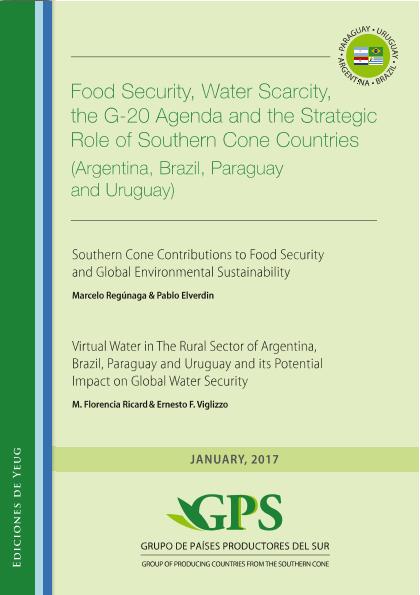Capítulo de Libro
Virtual water in the Rural Sector of Argentina Brazil Paraguay and Uruguay and its Potential Impact on Global Food and Water Security
Título del libro: Food Security, Water Scarcity, the G-20 Agenda and the Strategic Role of Southern Cone Countries (Argentina, Brazil, Paraguay and Uruguay)
Fecha de publicación:
2017
Editorial:
Ediciones De Yeug
ISBN:
978-987-98278-8-8
Idioma:
Inglés
Clasificación temática:
Resumen
There are strong links between water, agriculture and the economy in the ABPU region (Argentina, Brazil, Paraguay and Uruguay). Even more, agriculture is a significant economic sector for this region with some being major world players in the agricultural commodities world markets, such is the case for Brazil and Argentina who contribute to 13% of the global green water export. Virtual water (VW) was used as an indicator to estimate the total volume of freshwater that is used to produce goods and services consumed and traded by a nation as result of activities within the different sectors of the economy, in this case agriculture.The consumptive water use of agricultural production was on average 696.5Gm3/yr (or billion m3/yr) for the period 1996-2005; of which, 94% corresponds to the green VW (water from soil moisture and rain), whereas 3% refers to the blue component (water for irrigation). Grazing represents 25% of the total green VW of agriculture production in these countries. The remaining 75% belongs to crop production, with a large share destined to soybean production. This indicates that ABPU relies heavily on green water for agricultural production, i.e. rainfed agriculture. The incidence of irrigation is not important in the ABPU region. Concerning agricultural products, the ABPU region has been a net exporter of green (182.7 Gm3/yr) with negligible amounts of blue (1.9 Gm3/yr) VW. Besides, all ABPU countries show high national water self-sufficiency (91%), defined as the ratio of the internal to the total VW of national consumption. This means that these countries use their own available resources to supply most of the agricultural products consumed by their inhabitants. Under this view, ABPU agricultural production significantly contributes to the water security of destination countries of its exports (mainly Asian and European countries). Most of the VW is provided by Brazil through traded meat. Thus, mainly green, but also blue water plays a significant role for ABPU economies and for food security. Sustainable water management should not be seen as a barrier for the development of the region, but rather as the way to develop and grow as a region.
Palabras clave:
VIRTUAL WATER
,
RURAL SECTOR
,
ABPU REGION
,
WATER SECURITY
Archivos asociados
Licencia
Identificadores
Colecciones
Capítulos de libros(INCITAP)
Capítulos de libros de INST.D/CS D/L/TIERRA Y AMBIENTALES D/L/PAMPA
Capítulos de libros de INST.D/CS D/L/TIERRA Y AMBIENTALES D/L/PAMPA
Citación
Ricard, Maria Florencia; Viglizzo, Ernesto Francisco; Virtual water in the Rural Sector of Argentina Brazil Paraguay and Uruguay and its Potential Impact on Global Food and Water Security; Ediciones De Yeug; 2017; 85-123
Compartir




